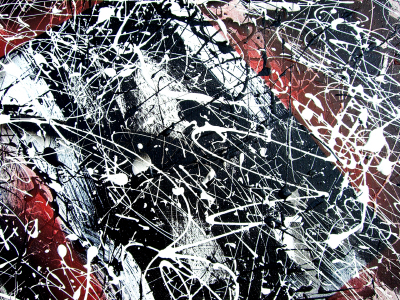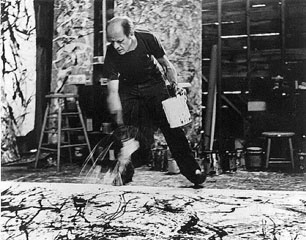Wednesday 09th December 2015Pollock's Provenance

A group of paintings supposedly by the famed Abstract Expressionist artist Jackson Pollock are under close review by a team of experts after doubts were raised about the authenticity of the pieces. A whopping 30 paintings were being examined by UK-based Art Analysis & Research, an authentication firm that specializes in the forensic analysis of artwork. Of the larger group, 12 were found to use a paint pigment that wasn't commercially available before Pollock's untimely death in 1956.
The pigment in question, CI Pigment Yellow 74, could possibly have been used another way, but it creates an awkward situation for the Nevada gallery Classic Fine Art, which exhibited 6 of the paintings in question this past July at the Art Monaco fair. That wasn't the first time the works have been displayed, either - they have appeared variously at the University of California, Berkeley, and the Museum of Biblical Art in Dallas. Beyond the pigment problems, the provenance of the entire batch of 30 is thrown into question by a rather sketchy backstory filled with anonymous donors and suspiciously low prices.
The reports on the works in question by Art Analysis & Research are very specific: "The earliest forms of this class of pigment appeared on the commercial market in 1910 (PY1), with others following in the 1920s (such as PY4-6). However, the date of introduction of PY74 is commonly given in the literature as 1957. This consequently raises a number of issues."
They go on to suggest that more testing be done, and include the conjecture that it is possible that the manufacturers provided Pollock with a number of pigments before they were more generally commercially available, but it seems somewhat unlikely that this would have happened without any sort of record of the exchange taking place, either in Pollock's notes or correspondence, or the company's papers - surely it would have been quite a marketing coup to have a popular artist working with and testing new paint compositions.
Classic Fine Art leaves with a final word on the matter: “We will stand by the results, whatever they are.” Kudos to them for bearing up remarkably well under a bad situation, but here's hoping they haven't been duped. The world can always use more beautiful art, and unfortunately Pollock won't be making any more himself.
Posted on December 09th 2015 on 04:25pm
0 Comments
Friday 20th March 2015Artist Spotlight: Jackson Pollock

One of the most interesting artists of the last century is the American artist Jackson Pollock. Since we're just entering the Spring season properly, and one of Pollock's most famous periods was named the Springs period, it only seemed appropriate that we stop to take a look at him and his work in this edition of the Artist Spotlight. Even though we normally look at artists who are currently active, and Pollock passed away back in the mid-1950's, his influence on modern art is undeniable.
As a pioneer of the abstract expressionist school, Pollock is incredibly famous for the unique style of his artwork, commonly known as 'drip painting'. If you've ever seen a single Pollock, the reason for the name will be immediately apparent. The entire style is characterized by spatters and droplets, thrown against the canvas with a wild abandon. The Springs period we mentioned earlier was the time in his career when he established himself as an artist to watch, creating some of his most famous works in the converted studio of his home in the neighbourhood of Springs, in East Hampton, Long Island. Interestingly, as he was being lauded for his work in the style, as Life magazine featured him in a four page spread that asked the question, "Is he the greatest living painter in the United States?" he abruptly decided to change his style, and completely distanced himself from the drip painting style he is so famous for.
Unfortunately, like many great artists, he struggled with substance abuse, and his excessive alcoholism has been attributed as the cause of his death, which occurred in 1954 as a result of a single-vehicle automobile accident. His legacy, however, is best summed up in this excerpt from a book on his life and work by Pepe Karmel:
"Pollock’s finest paintings… reveal that his all-over line does not give rise to positive or negative areas: we are not made to feel that one part of the canvas demands to be read as figure, whether abstract or representational, against another part of the canvas read as ground. There is not inside or outside to Pollock’s line or the space through which it moves…. Pollock has managed to free line not only from its function of representing objects in the world, but also from its task of describing or bounding shapes or figures, whether abstract or representational, on the surface of the canvas."
Posted on March 20th 2015 on 10:51pm
0 Comments
 A group of paintings supposedly by the famed Abstract Expressionist artist Jackson Pollock are under close review by a team of experts after doubts were raised about the authenticity of the pieces. A whopping 30 paintings were being examined by UK-based Art Analysis & Research, an authentication firm that specializes in the forensic analysis of artwork. Of the larger group, 12 were found to use a paint pigment that wasn't commercially available before Pollock's untimely death in 1956.
A group of paintings supposedly by the famed Abstract Expressionist artist Jackson Pollock are under close review by a team of experts after doubts were raised about the authenticity of the pieces. A whopping 30 paintings were being examined by UK-based Art Analysis & Research, an authentication firm that specializes in the forensic analysis of artwork. Of the larger group, 12 were found to use a paint pigment that wasn't commercially available before Pollock's untimely death in 1956. One of the most interesting artists of the last century is the American artist Jackson Pollock. Since we're just entering the Spring season properly, and one of Pollock's most famous periods was named the Springs period, it only seemed appropriate that we stop to take a look at him and his work in this edition of the Artist Spotlight. Even though we normally look at artists who are currently active, and Pollock passed away back in the mid-1950's, his influence on modern art is undeniable.
One of the most interesting artists of the last century is the American artist Jackson Pollock. Since we're just entering the Spring season properly, and one of Pollock's most famous periods was named the Springs period, it only seemed appropriate that we stop to take a look at him and his work in this edition of the Artist Spotlight. Even though we normally look at artists who are currently active, and Pollock passed away back in the mid-1950's, his influence on modern art is undeniable.



